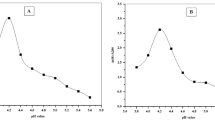Abstract
THE possibility that the water soluble phycobilin pigments of red algae show physical properties of taxonomic significance at the generic level has been frequently explored. The three main phycoerythrin “types” described are C, B and R-phycoerythrin, based on their plant sources (from the Cyanophyceae, and from the sub-classes Bangiophycidae and Florideophycidae (Rhodophyceae) respectively), and on their absorption spectra. These “types” have been further described as “single”, “two” and “three peak” phycoerythrins, with peaks at 550 mµ, 565 and 550 mµ, and 565, 540 and 496 mµ, respectively1. It has also been shown in a recent review that the taxonomic implications are not entirely reliable2. Thus, in the genus Rhodochorton (order Nemalionales, Florideophycidae), R-phycoerythrin was obtained from R. purpureum (Lightf.) Rosenv. (= R. rothii)3, and B-phycoerythrin from R. floridulum (Dillw.) Nag.4. In a recent survey of the phycoerythrins from forty-four species of red algae from Japan, three “types” were again described, a “single peak” phycoerythrin from Compsopogon oishii (Bangiphycidae), with λmax at 565 mµ and a “shoulder” at 542 mµ; “two peak” phycoerythrin (peaks at 565 and 495 mµ, with a “shoulder” at 545 mµ) from Bangia and Porphyra (Bangiophycidae) and from Batrachospermum, Chantransia (= Acrochaetium) and Sirodotia (order Nemalionales, Florideophycidae); and “three peak” phycoerythrin (with peaks at 560–570 mµ, 535–545 mµ and 490–500 mµ) extracted from numerous representatives of the Florideophycidae5. It seems likely that the pigment “types” described from Japan represent different interpretations of the positions of maxima on the absorption spectra, and such differences can result from both the physiological conditions of the plants and the modes of pigment extraction2. Thus the “two peak” phycoerythrin described from Japan was considered to be a form of R-phycoerythrin, and similar to that described for Porphyra from a number of other sources6–10. It was also suggested, however, that these three pigment “types” might prove of taxonomic significance, with the “single peak” phycoerythrin being typical of primitive red algae, then the plants possessing the “two peaks and shoulder” phycoerythrin being next in order of advance, and the “three peak” phycoerythrin being characteristic of advanced genera.
This is a preview of subscription content, access via your institution
Access options
Subscribe to this journal
Receive 51 print issues and online access
$199.00 per year
only $3.90 per issue
Buy this article
- Purchase on Springer Link
- Instant access to full article PDF
Prices may be subject to local taxes which are calculated during checkout
Similar content being viewed by others
References
Blinks, L. R., Ann. Rev. Plant Physiol., 5, 93 (1954).
O'heocha, C., Physiology and Biochemistry of Algae (edit. by Lewin, R. A.), 421 (1962).
O'heocha, C., Arch. Biochem. Biophys., 73, 207 (1958).
O'heocha, C., and O'carra, P., J. Amer. Chem. Soc., 83, 1091 (1961).
Hirose, H., and Kumano, S., Bot. Mag., Tokyo, 79, 105 (1966).
Kitasato, Z., Acta Phytochim., 2, 274 (1925).
Svedberg, T., and Katsurai, T., J. Amer. Chem. Soc., 51, 3573 (1929).
Fujiwara, T., J. Biochem., 42, 411 (1955).
Haxo, F. T., and Blinks, L. R., J. Gen. Physiol., 33, 389 (1950).
Haxo, F. T., and Fork, D. C., Nature, 184, 1051 (1955).
White, E. B., and Boney, A. D., Brit. Phycol. Bull., 3, 343 (1967).
Stoloff, L., and Silva, P., Econ. Bot., 11, 327 (1957).
Stoloff, L., Econ. Bot., 16, 86 (1962).
Augier, J., Rev. Gen. Bot., 60, 257 (1953).
O'heocha, C., Colloq. Intern. Centre Nat. Rech. Sc., 103, 121 (1961).
Boney, A. D., Brit. Phycol. Bull., 3, 317 (1967).
Dixon, P. S., Oceanog. Mar. Biol. Ann. Rev., 1, 177 (1963).
Umezaki, I., Rev. Algol. NS, 9, 19 (1967).
Author information
Authors and Affiliations
Rights and permissions
About this article
Cite this article
BONEY, A., WHITE, E. Phycoerythrins from some Acrochaetium Species. Nature 218, 1068–1069 (1968). https://doi.org/10.1038/2181068a0
Received:
Issue Date:
DOI: https://doi.org/10.1038/2181068a0
This article is cited by
Comments
By submitting a comment you agree to abide by our Terms and Community Guidelines. If you find something abusive or that does not comply with our terms or guidelines please flag it as inappropriate.



